Hyundai Genesis 2014 Owner's Manual
Manufacturer: HYUNDAI, Model Year: 2014, Model line: Genesis, Model: Hyundai Genesis 2014Pages: 546, PDF Size: 13.59 MB
Page 371 of 546
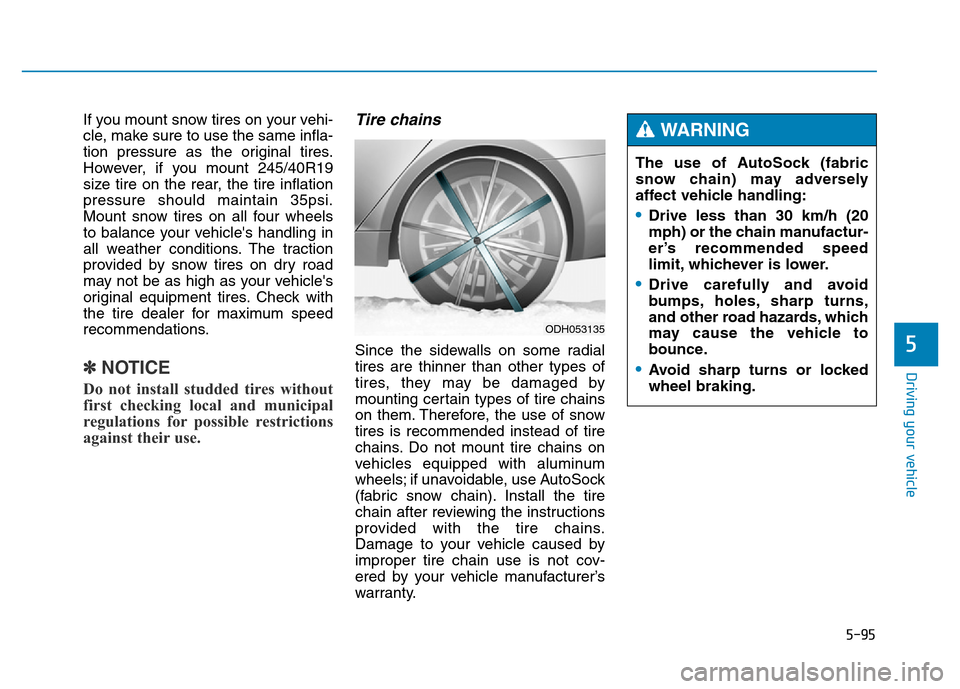
5-95
Driving your vehicle
5
If you mount snow tires on your vehi-
cle, make sure to use the same infla-
tion pressure as the original tires.
However, if you mount 245/40R19
size tire on the rear, the tire inflation
pressure should maintain 35psi.
Mount snow tires on all four wheels
to balance your vehicle's handling in
all weather conditions. The traction
provided by snow tires on dry road
may not be as high as your vehicle's
original equipment tires. Check with
the tire dealer for maximum speed
recommendations.
✽NOTICE
Do not install studded tires without
first checking local and municipal
regulations for possible restrictions
against their use.
Tire chains
Since the sidewalls on some radial
tires are thinner than other types of
tires, they may be damaged by
mounting certain types of tire chains
on them. Therefore, the use of snow
tires is recommended instead of tire
chains. Do not mount tire chains on
vehicles equipped with aluminum
wheels; if unavoidable, use AutoSock
(fabric snow chain). Install the tire
chain after reviewing the instructions
provided with the tire chains.
Damage to your vehicle caused by
improper tire chain use is not cov-
ered by your vehicle manufacturer’s
warranty.The use of AutoSock (fabric
snow chain) may adversely
affect vehicle handling:
•Drive less than 30 km/h (20
mph) or the chain manufactur-
er’s recommended speed
limit, whichever is lower.
•Drive carefully and avoid
bumps, holes, sharp turns,
and other road hazards, which
may cause the vehicle to
bounce.
•Avoid sharp turns or locked
wheel braking.
WARNING
ODH053135
Page 372 of 546
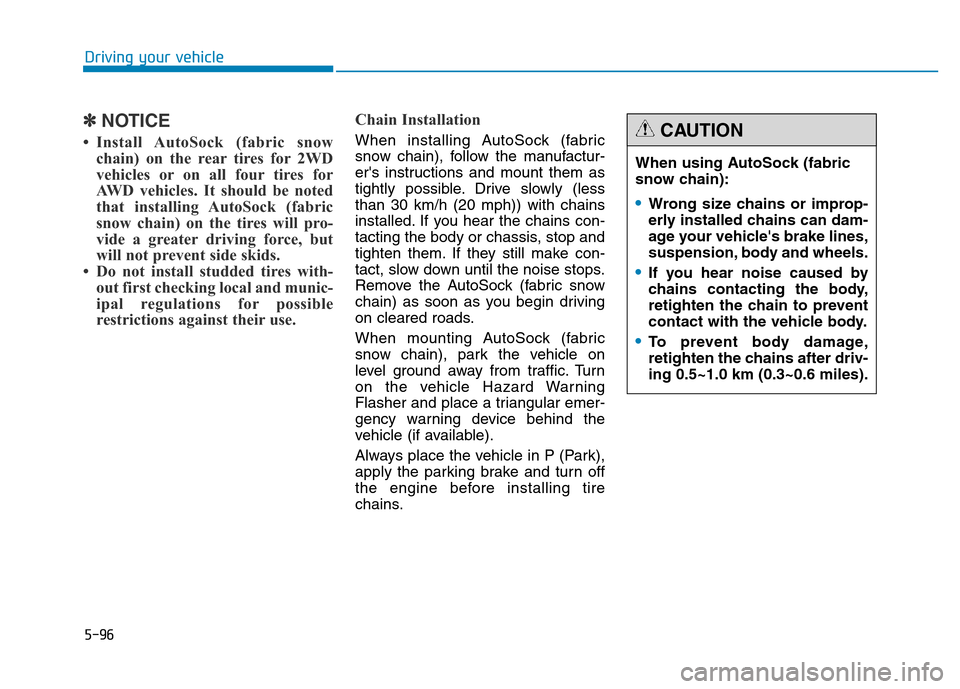
5-96
Driving your vehicle
✽NOTICE
• Install AutoSock (fabric snow
chain) on the rear tires for 2WD
vehicles or on all four tires for
AWD vehicles. It should be noted
that installing AutoSock (fabric
snow chain) on the tires will pro-
vide a greater driving force, but
will not prevent side skids.
• Do not install studded tires with-
out first checking local and munic-
ipal regulations for possible
restrictions against their use.Chain InstallationWhen installing AutoSock (fabric
snow chain), follow the manufactur-
er's instructions and mount them as
tightly possible. Drive slowly (less
than 30 km/h (20 mph)) with chains
installed. If you hear the chains con-
tacting the body or chassis, stop and
tighten them. If they still make con-
tact, slow down until the noise stops.
Remove the AutoSock (fabric snow
chain) as soon as you begin driving
on cleared roads.
When mounting AutoSock (fabric
snow chain), park the vehicle on
level ground away from traffic. Turn
on the vehicle Hazard Warning
Flasher and place a triangular emer-
gency warning device behind the
vehicle (if available).
Always place the vehicle in P (Park),
apply the parking brake and turn off
the engine before installing tire
chains.When using AutoSock (fabric
snow chain):
•Wrong size chains or improp-
erly installed chains can dam-
age your vehicle's brake lines,
suspension, body and wheels.
•If you hear noise caused by
chains contacting the body,
retighten the chain to prevent
contact with the vehicle body.
•To prevent body damage,
retighten the chains after driv-
ing 0.5~1.0 km (0.3~0.6 miles).
CAUTION
Page 373 of 546
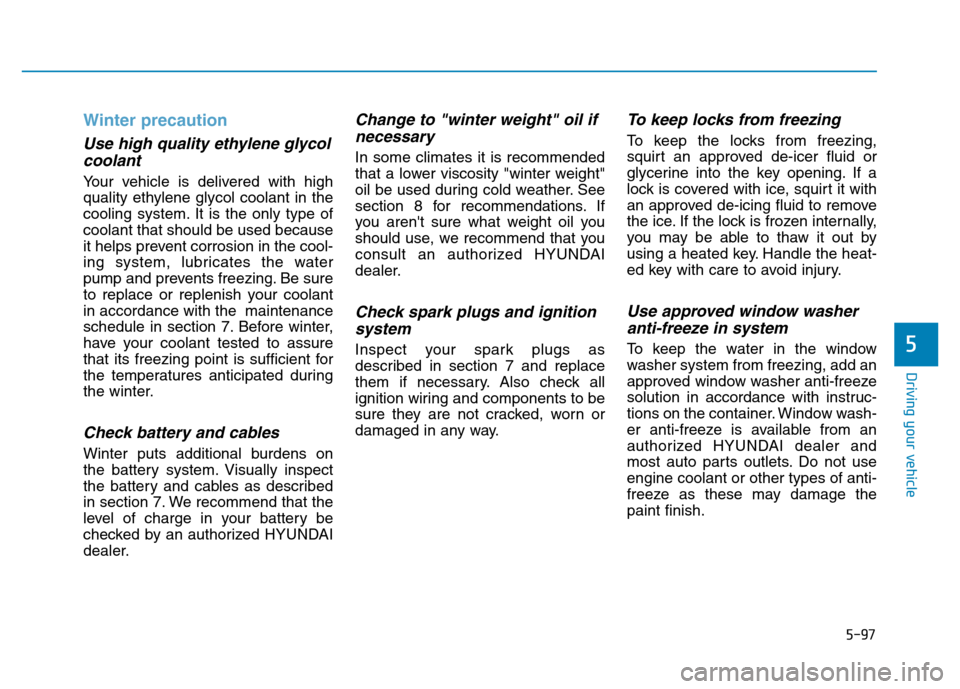
5-97
Driving your vehicle
Winter precaution
Use high quality ethylene glycol
coolant
Your vehicle is delivered with high
quality ethylene glycol coolant in the
cooling system. It is the only type of
coolant that should be used because
it helps prevent corrosion in the cool-
ing system, lubricates the water
pump and prevents freezing. Be sure
to replace or replenish your coolant
in accordance with the maintenance
schedule in section 7. Before winter,
have your coolant tested to assure
that its freezing point is sufficient for
the temperatures anticipated during
the winter.
Check battery and cables
Winter puts additional burdens on
the battery system. Visually inspect
the battery and cables as described
in section 7. We recommend that the
level of charge in your battery be
checked by an authorized HYUNDAI
dealer.
Change to "winter weight" oil if
necessary
In some climates it is recommended
that a lower viscosity "winter weight"
oil be used during cold weather. See
section 8 for recommendations. If
you aren't sure what weight oil you
should use, we recommend that you
consult an authorized HYUNDAI
dealer.
Check spark plugs and ignition
system
Inspect your spark plugs as
described in section 7 and replace
them if necessary. Also check all
ignition wiring and components to be
sure they are not cracked, worn or
damaged in any way.
To keep locks from freezing
To keep the locks from freezing,
squirt an approved de-icer fluid or
glycerine into the key opening. If a
lock is covered with ice, squirt it with
an approved de-icing fluid to remove
the ice. If the lock is frozen internally,
you may be able to thaw it out by
using a heated key. Handle the heat-
ed key with care to avoid injury.
Use approved window washer
anti-freeze in system
To keep the water in the window
washer system from freezing, add an
approved window washer anti-freeze
solution in accordance with instruc-
tions on the container. Window wash-
er anti-freeze is available from an
authorized HYUNDAI dealer and
most auto parts outlets. Do not use
engine coolant or other types of anti-
freeze as these may damage the
paint finish.5
Page 374 of 546
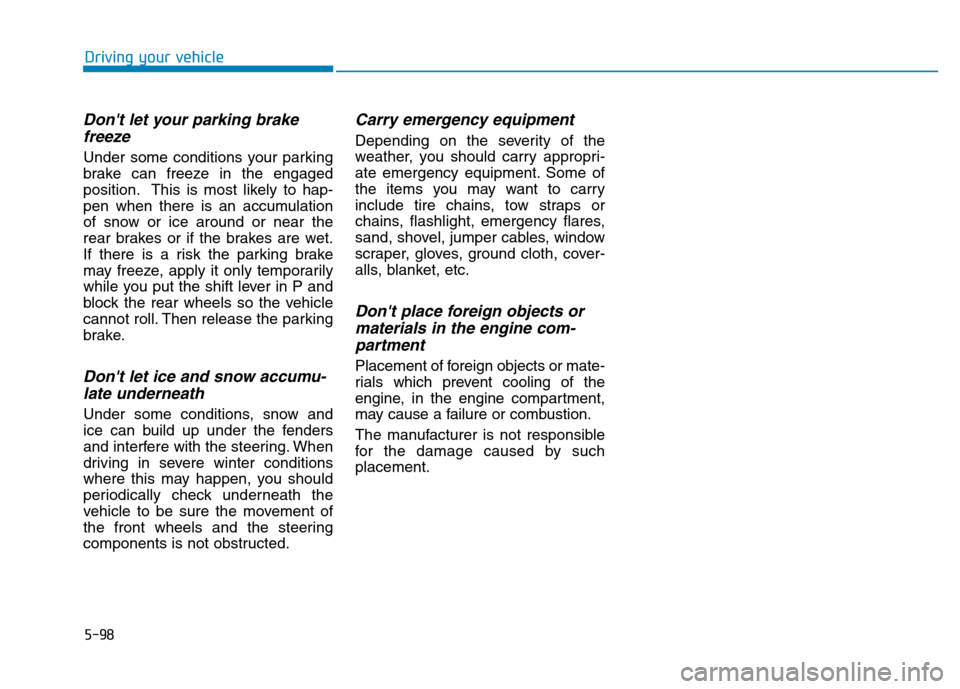
5-98
Don't let your parking brake
freeze
Under some conditions your parking
brake can freeze in the engaged
position. This is most likely to hap-
pen when there is an accumulation
of snow or ice around or near the
rear brakes or if the brakes are wet.
If there is a risk the parking brake
may freeze, apply it only temporarily
while you put the shift lever in P and
block the rear wheels so the vehicle
cannot roll. Then release the parking
brake.
Don't let ice and snow accumu-
late underneath
Under some conditions, snow and
ice can build up under the fenders
and interfere with the steering. When
driving in severe winter conditions
where this may happen, you should
periodically check underneath the
vehicle to be sure the movement of
the front wheels and the steering
components is not obstructed.
Carry emergency equipment
Depending on the severity of the
weather, you should carry appropri-
ate emergency equipment. Some of
the items you may want to carry
include tire chains, tow straps or
chains, flashlight, emergency flares,
sand, shovel, jumper cables, window
scraper, gloves, ground cloth, cover-
alls, blanket, etc.
Don't place foreign objects or
materials in the engine com-
partment
Placement of foreign objects or mate-
rials which prevent cooling of the
engine, in the engine compartment,
may cause a failure or combustion.
The manufacturer is not responsible
for the damage caused by such
placement.
Driving your vehicle
Page 375 of 546

5-99
Driving your vehicle
5
Two labels on your driver’s door sill
show how much weight your vehicle
was designed to carry: the Tire and
Loading Information Label and the
Certification Label.
Before loading your vehicle, familiar-
ize yourself with the following terms
for determining your vehicle's weight
ratings, from the vehicle's specifica-
tions and the Certification Label:
Base Curb Weight
This is the weight of the vehicle
including a full tank of fuel and all
standard equipment. It does not
include passengers, cargo, or option-
al equipment.
Vehicle Curb Weight
This is the weight of your new vehicle
when you picked it up from your deal-
er plus any aftermarket equipment.
Cargo Weight
This figure includes all weight added
to the Base Curb Weight, including
cargo and optional equipment.GAW (Gross Axle Weight)
This is the total weight placed on
each axle (front and rear) - including
vehicle curb weight and all payload.
GAWR (Gross Axle Weight Rating)
This is the maximum allowable
weight that can be carried by a single
axle (front or rear). These numbers
are shown on the Certification Label.
The total load on each axle must
never exceed its GAWR.
GVW (Gross Vehicle Weight)
This is the Base Curb Weight plus
actual Cargo Weight plus passen-
gers.
GVWR (Gross Vehicle Weight
Rating)
This is the maximum allowable
weight of the fully loaded vehicle
(including all options, equipment,
passengers and cargo). The GVWR
is shown on the Certification Label
located on the driver’s door sill.Overloading
VEHICLE WEIGHT
The Gross Axle Weight Rating
(GAWR) and the Gross Vehicle
Weight Rating (GVWR) for your
vehicle are on the Certification
Label attached to the driver's
(or front passenger
Page 376 of 546
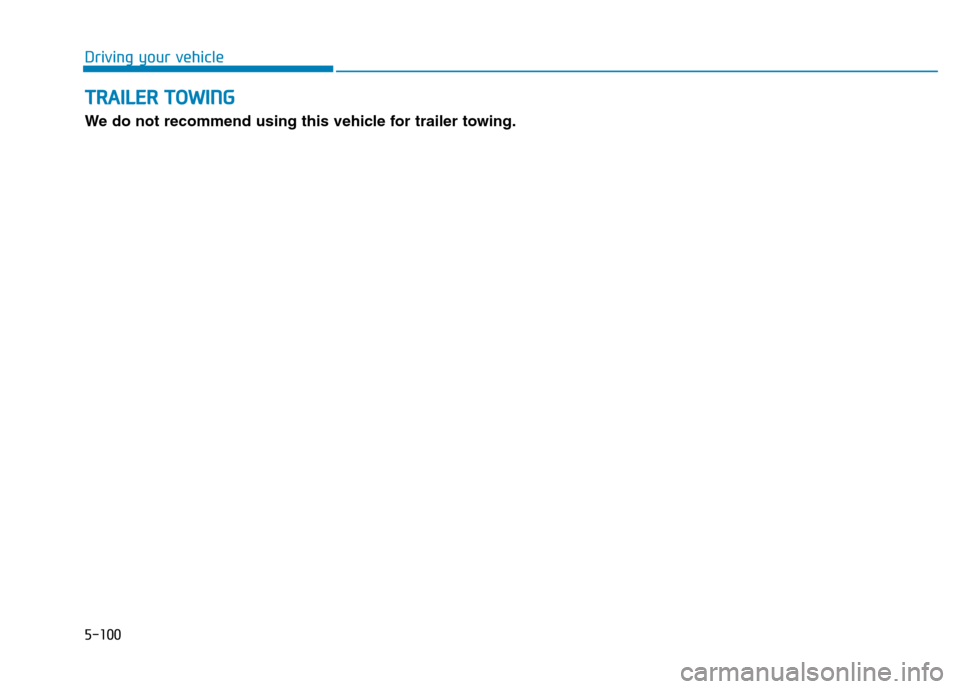
5-100
Driving your vehicle
TRAILER TOWING
We do not recommend using this vehicle for trailer towing.
Page 377 of 546
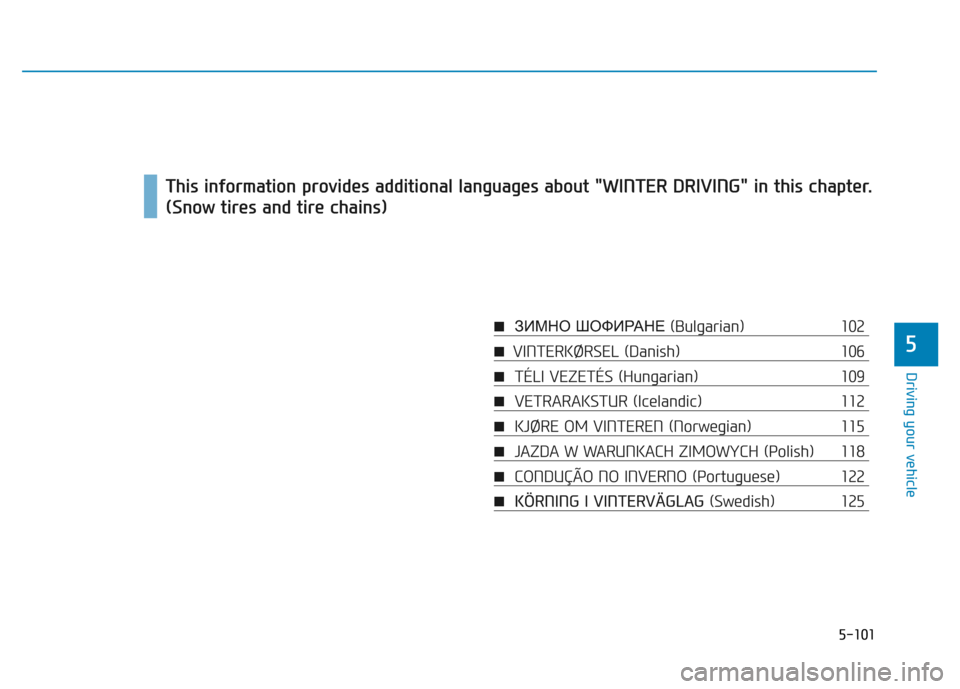
5-101
Driving your vehicle
5
■ЗИМНО ШОФИРАНЕ (Bulgarian) 102
■ VINTERKØRSEL (Danish) 106
■TÉLI VEZETÉS (Hungarian) 109
■VETRARAKSTUR (Icelandic) 112
■KJØRE OM VINTEREN (Norwegian) 115
■JAZDA W WARUNKACH ZIMOWYCH (Polish) 118
■CONDUÇÃO NO INVERNO (Portuguese) 122
■KÖRNING I VINTERVÄGLAG(Swedish) 125
This information provides additional languages about "WINTER DRIVING" in this chapter.
(Snow tires and tire chains)
Page 378 of 546
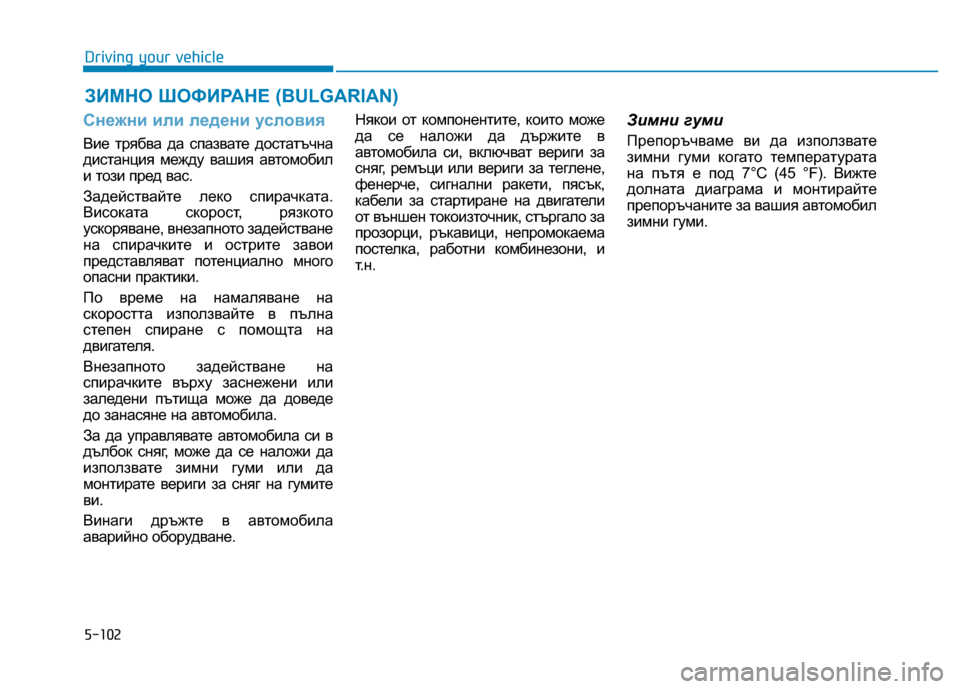
5-102
ЗИМНО ШОФИРАНЕ (BULGARIAN)
Driving your vehicle
Снежни или ледени условия
Вие трябва да спазвате достатъчна
дистанция между вашия автомобил
и този пред вас.
Задействайте леко спирачката.
Високата скорост, рязкото
ускоряване, внезапното задействане
на спирачките и острите завои
представляват потенциално много
опасни практики.
По време на намаляване на
скоростта използвайте в пълна
степен спиране с помощта на
двигателя.
Внезапното задействане на
спирачките върху заснежени или
заледени пътища може да доведе
до занасяне на автомобила.
За да управлявате автомобила си в
дълбок сняг, може да се наложи да
използвате зимни гуми или да
монтирате вериги за сняг на гумите
ви.
Винаги дръжте в автомобила
аварийно оборудване.Някои от компонентите, които може
да се наложи да държите в
автомобила си, включват вериги за
сняг, ремъци или вериги за теглене,
фенерче, сигнални ракети, пясък,
кабели за стартиране на двигатели
от външен токоизточник, стъргало за
прозорци, ръкавици, непромокаема
постелка, работни комбинезони, и
т. н .
Зимни гуми
Препоръчваме ви да използвате
зимни гуми когато температурата
на пътя е под 7°C (45 °F). Вижте
долната диаграма и монтирайте
препоръчаните за вашия автомобил
зимни гуми.
Page 379 of 546
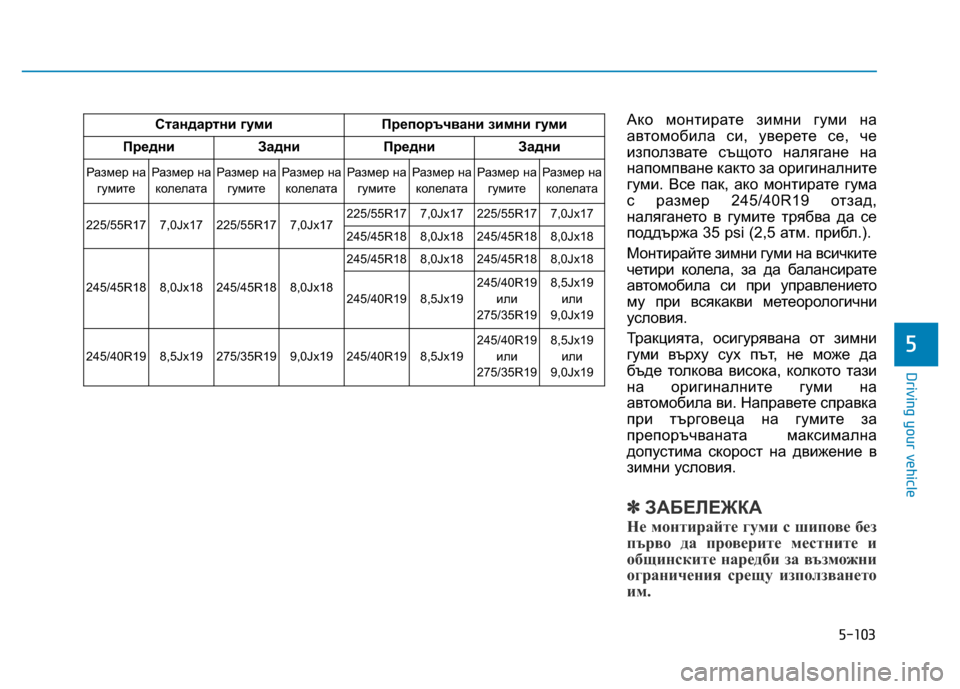
5-103
Driving your vehicle
Ако монтирате зимни гуми на
автомобила си, уверете се, че
използвате същото налягане на
напомпване както за оригиналните
гуми. Все пак, ако монтирате гума
с размер 245/40R19 отзад,
налягането в гумите трябва да се
поддържа 35 psi (2,5 атм. прибл.).
Монтирайте зимни гуми на всичките
четири колела, за да балансирате
автомобила си при управлението
му при всякакви метеорологични
условия.
Тракцията, осигурявана от зимни
гуми върху сух път, не може да
бъде толкова висока, колкото тази
на оригиналните гуми на
автомобила ви. Направете справка
при търговеца на гумите за
препоръчваната максимална
допустима скорост на движение в
зимни условия.
✽ЗАБЕЛЕЖКА
Не монтирайте гуми с шипове без
първо да проверите местните и
общинските наредби за възможни
ограничения срещу използването
им.
5
Стандартни гуми Препоръчвани зимни гуми
ПредниЗадниПредниЗадни
Размер на
гумитеРазмер на
колелатаРазмер на
гумитеРазмер на
колелатаРазмер на
гумитеРазмер на
колелатаРазмер на
гумитеРазмер на
колелата
225/55R17 7,0Jx17 225/55R17 7,0Jx17 225/55R17
7,0Jx17 225/55R17 7,0Jx17
245/45R18
8,0Jx18 245/45R18 8,0Jx18
245/45R18 8,0Jx18 245/45R18 8,0Jx18 245/45R18
8,0Jx18 245/45R18 8,0Jx18
245/40R19
8,5Jx19245/40R19
или
275/35R198,5Jx19
или
9,0Jx19
245/40R19 8,5Jx19 275/35R19 9,0Jx19 245/40R19
8,5Jx19245/40R19
или
275/35R19 8,5Jx19
или
9,0Jx19
Page 380 of 546
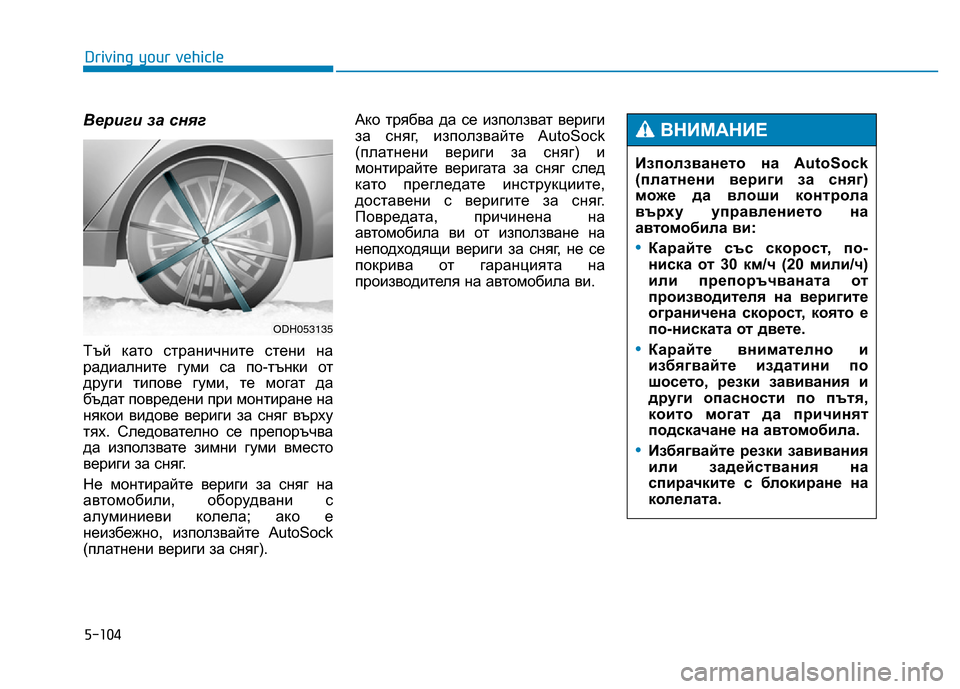
5-104
Driving your vehicle
Вериги за сняг
Тъй като страничните стени на
радиалните гуми са по-тънки от
други типове гуми, те могат да
бъдат повредени при монтиране на
някои видове вериги за сняг върху
тях. Следователно се препоръчва
да използвате зимни гуми вместо
вериги за сняг.
Не монтирайте вериги за сняг на
автомобили, оборудвани с
алуминиеви колела; ако е
неизбежно, използвайте AutoSock
(платнени вериги за сняг). Ако трябва да се използват вериги
за сняг, използвайте AutoSock
(платнени вериги за сняг) и
монтирайте веригата за сняг след
като прегледате инструкциите,
доставени с веригите за сняг.
Повредата, причинена на
автомобила ви от използване на
неподходящи вериги за сняг, не се
покрива от гаранцията на
производителя на автомобила ви.
ODH053135
Използването на AutoSock
(платнени вериги за сняг)
може да влоши контрола
върху управлението на
автомобила ви:
•Карайте със скорост, по-
ниска от 30 км/ч (20 мили/ч)
или препоръчваната от
производителя на веригите
ограничена скорост, която е
по-ниската от двете.
•Карайте внимателно и
избягвайте издатини по
шосето, резки завивания и
други опасности по пътя,
които могат да причинят
подскачане на автомобила.
•Избягвайте резки завивания
или задействания на
спирачките с блокиране на
колелата.
ВНИМАНИЕ